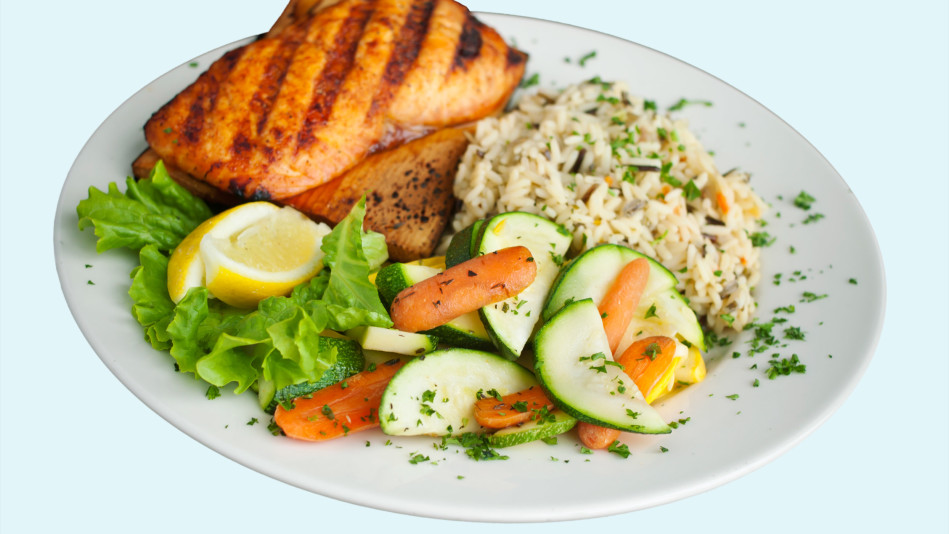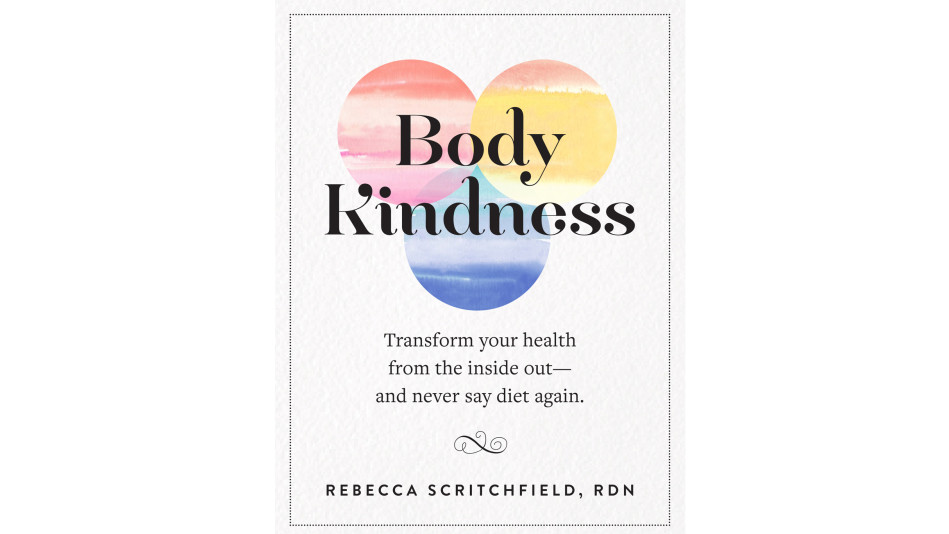This Is What a Healthy Plate Looks Like
A simple yet genius strategy for eating well from the author of Body Kindness.

Photo: rudisill/istockphoto
One way to increase the variety of foods you eat and simplify decision-making is by using the balanced plate method to guide your food choices. The perk is that there is no need to restrict or measure your food and no calorie counting or scrutinizing of ingredients. All you need is a pair of eyes and an elementary understanding of fractions. The concept is so simple it almost feels like it can't possibly work, but it does. (And just think of all the free time you’ll have when you aren't entering every morsel of food into a calorie counting app!)
When you look at the balanced plates, you may notice one important feature: Within the realm of your preferences, plants should be the basis of your food intake. Why? They offer fiber, vitamins, and minerals for nourishment. One-half to three quarters of the plate diagrams are plant foods—fruits, vegetables, beans, legumes, seeds, nuts, and whole-grain foods. Plant-based eating is in line with the USDA's Dietary Guidelines for Americans, which is updated every five years by a panel of nutrition scientists. As long as you work on adequately filling this part of the plate MOST of the time, the rest of your decisions become less important (and less difficult).
Don’t forget to save room for my favorite part of the balanced plate approach: It's called eating whatever the heck you want. (You rebel, you!) I'm talking some meals that have no vegetables or fruits at all. Life is meant to be lived fully—not monitored and morseled out into perfect portions. But what about health? Enjoying pizza, french fries, and hot fudge sundaes does not give someone diabetes. But it might just give them joy once in a while. We've all heard of someone’s Aunty Betty who lived to be 101 eating bacon and mayonnaise sandwiches every day from her easy chair. And we all know people who seem to have done everything by the book yet still struggle with unexplainable health challenges. While your lifestyle choices can impact health, so can genetics, the environment, and even socioeconomic status. I want to enjoy the years I have on this planet, and taking pleasure in flexible, adventurous eating fits my definition of "the good life" more than forcing myself to always adhere to a balanced plate—or else!

Illustration: Jean-Marc Troadec / Workman
Plus, 6 Ways the Balanced Plate Works for You
Supports your day-to-day energy.
When you eat better, you tend to feel better, sleep better, and as a collective result, have more energy.
Maximizes your digestive health.
Foods rich in fiber will keep your digestive system running smoothly, helping you absorb nutrients, which then fuel all your other body functions.
Strengthens your gut microbiome.
One hundred trillion of your body's best friends, otherwise known as the bacteria living in your gut, make up what is known as your microbiome—considered your "second brain." It's key to regulating your mood through the signaling of neurotransmitters and production of serotonin, which I like to think of as the "keep calm and carry on" hormone. When you eat certain foods, like bananas, artichokes, and kiwi, you get undigestable fibers called prebiotics that feed your "good bacteria." Eating fermented foods like yogurt, kefir, kimchi, and miso gives you a direct dose of probiotics to help populate your gut. You can also take probiotic supplements. All these efforts will help the most beneficial bacteria thrive in your gut and keep potentially harmful viruses and bacteria from taking up residence.
Boosts your immunity.
Your immune system is constantly fighting any potentially harmful pathogens that make it into your body. Eating foods with the antioxidants vitamins A, C, and E help keep your immune system strong. The yellow-flesh SunGold kiwifruit has three times the vitamin C of oranges. Also try blueberries, grapefruit, broccoli, avocado, mangoes, carrots, sweet potatoes, seeds, and nuts.
Helps your body naturally detoxify.
You don’t need cleanses or detoxes because your liver and kidneys do all the hard work for you. Your liver sifts through every ounce of blood looking for anything it does not like and getting rid of it (like alcohol, prescription drugs, or other body toxins). Then your kidneys help turn it into waste so when you "go" it goes bye-bye. Keep this process operating smoothly by drinking plenty of water and keeping alcohol intake in check.
Fights inflammation.
Sometimes your body responds to injury or illness with pain and discomfort in an attempt to heal itself—this can also happen with food intolerance or sensitivities or certain chronic illnesses such as Crohn's disease, lupus, or arthritis. The majority of leafy greens, fruits, and other healthful foods like nuts, olive oil, celery, beets, salmon, tuna, and anchovies are anti-inflammatory. This can help decrease generalized inflammation in your body.

Excerpted from Body Kindness by Rebecca Scritchfield. Reprinted by permission of Workman Publishing. Company.
Want more stories like this delivered to your inbox? Sign up for the Oprah.com Healthy Body Newsletter!
When you look at the balanced plates, you may notice one important feature: Within the realm of your preferences, plants should be the basis of your food intake. Why? They offer fiber, vitamins, and minerals for nourishment. One-half to three quarters of the plate diagrams are plant foods—fruits, vegetables, beans, legumes, seeds, nuts, and whole-grain foods. Plant-based eating is in line with the USDA's Dietary Guidelines for Americans, which is updated every five years by a panel of nutrition scientists. As long as you work on adequately filling this part of the plate MOST of the time, the rest of your decisions become less important (and less difficult).
Don’t forget to save room for my favorite part of the balanced plate approach: It's called eating whatever the heck you want. (You rebel, you!) I'm talking some meals that have no vegetables or fruits at all. Life is meant to be lived fully—not monitored and morseled out into perfect portions. But what about health? Enjoying pizza, french fries, and hot fudge sundaes does not give someone diabetes. But it might just give them joy once in a while. We've all heard of someone’s Aunty Betty who lived to be 101 eating bacon and mayonnaise sandwiches every day from her easy chair. And we all know people who seem to have done everything by the book yet still struggle with unexplainable health challenges. While your lifestyle choices can impact health, so can genetics, the environment, and even socioeconomic status. I want to enjoy the years I have on this planet, and taking pleasure in flexible, adventurous eating fits my definition of "the good life" more than forcing myself to always adhere to a balanced plate—or else!

Illustration: Jean-Marc Troadec / Workman
Plus, 6 Ways the Balanced Plate Works for You
Supports your day-to-day energy.
When you eat better, you tend to feel better, sleep better, and as a collective result, have more energy.
Maximizes your digestive health.
Foods rich in fiber will keep your digestive system running smoothly, helping you absorb nutrients, which then fuel all your other body functions.
Strengthens your gut microbiome.
One hundred trillion of your body's best friends, otherwise known as the bacteria living in your gut, make up what is known as your microbiome—considered your "second brain." It's key to regulating your mood through the signaling of neurotransmitters and production of serotonin, which I like to think of as the "keep calm and carry on" hormone. When you eat certain foods, like bananas, artichokes, and kiwi, you get undigestable fibers called prebiotics that feed your "good bacteria." Eating fermented foods like yogurt, kefir, kimchi, and miso gives you a direct dose of probiotics to help populate your gut. You can also take probiotic supplements. All these efforts will help the most beneficial bacteria thrive in your gut and keep potentially harmful viruses and bacteria from taking up residence.
Boosts your immunity.
Your immune system is constantly fighting any potentially harmful pathogens that make it into your body. Eating foods with the antioxidants vitamins A, C, and E help keep your immune system strong. The yellow-flesh SunGold kiwifruit has three times the vitamin C of oranges. Also try blueberries, grapefruit, broccoli, avocado, mangoes, carrots, sweet potatoes, seeds, and nuts.
Helps your body naturally detoxify.
You don’t need cleanses or detoxes because your liver and kidneys do all the hard work for you. Your liver sifts through every ounce of blood looking for anything it does not like and getting rid of it (like alcohol, prescription drugs, or other body toxins). Then your kidneys help turn it into waste so when you "go" it goes bye-bye. Keep this process operating smoothly by drinking plenty of water and keeping alcohol intake in check.
Fights inflammation.
Sometimes your body responds to injury or illness with pain and discomfort in an attempt to heal itself—this can also happen with food intolerance or sensitivities or certain chronic illnesses such as Crohn's disease, lupus, or arthritis. The majority of leafy greens, fruits, and other healthful foods like nuts, olive oil, celery, beets, salmon, tuna, and anchovies are anti-inflammatory. This can help decrease generalized inflammation in your body.

Excerpted from Body Kindness by Rebecca Scritchfield. Reprinted by permission of Workman Publishing. Company.
Want more stories like this delivered to your inbox? Sign up for the Oprah.com Healthy Body Newsletter!



